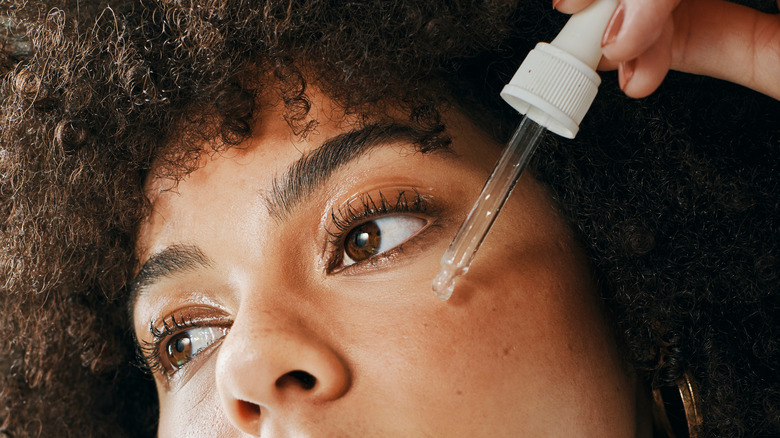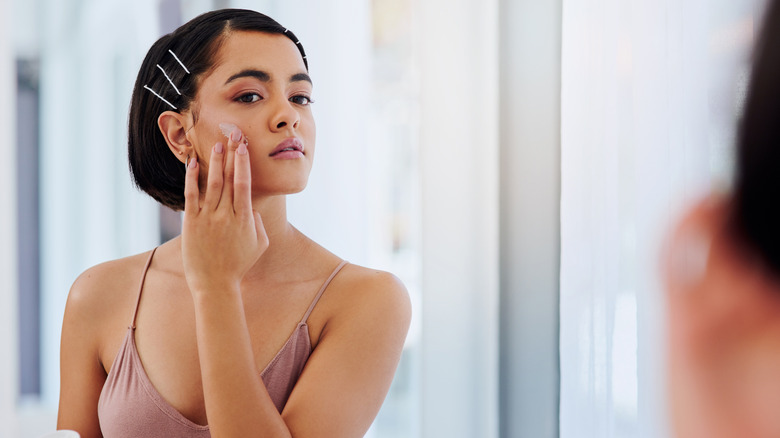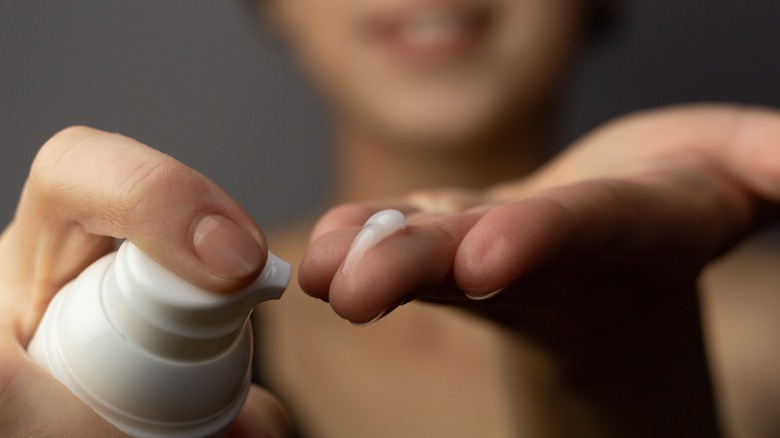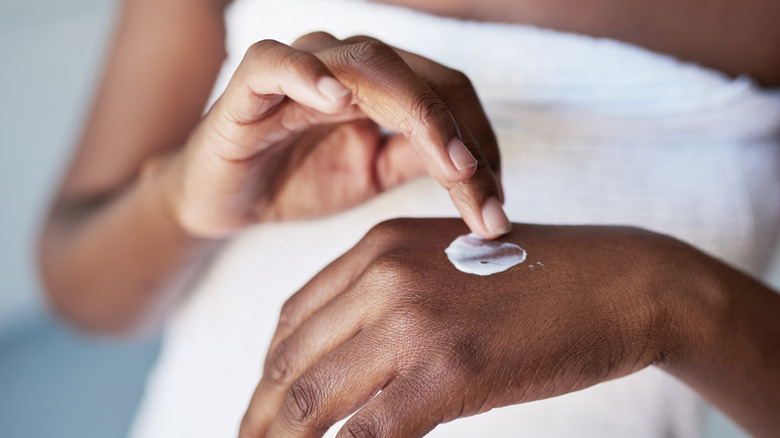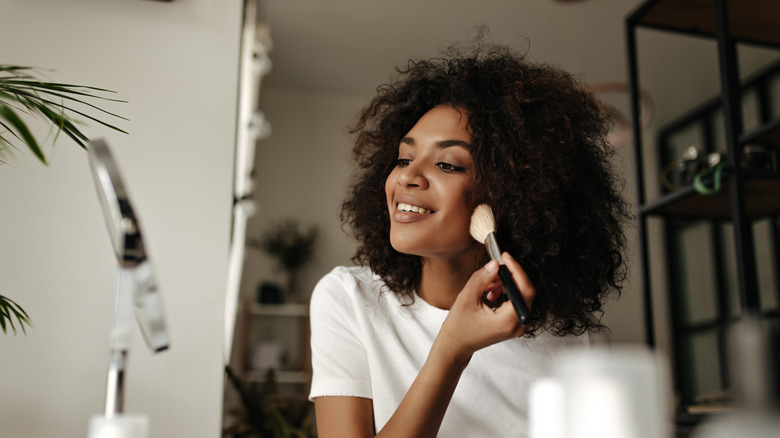Tips For Wearing Makeup While Dealing With Retinol Peeling
We may receive a commission on purchases made from links.
One common misconception about peeling skin caused by retinol usage? That it only affects retinol newbies. As it turns out, even seasoned tretinoin users can fall victim to flakiness if they neglect to apply the anti-aging treatment consistently. Waking up to retinol-induced irritation is bad enough on its own, but it's even harder for those who love wearing makeup. Whether you're into tinted moisturizer, sunscreen, or foundation, there's nothing worse than struggling to apply your morning skincare products over dry, peeling skin. Some may even feel tempted to stop using retinol — or makeup — as a result.
But before you decide to ditch the makeup entirely, there are a few ways to get around the patchiness caused by a retinol purge. From changing the way you apply retinol to switching up your daily products, it's easy to ride out retinol's effects without giving up cosmetics altogether. Ready to learn how to wear makeup over dry skin caused by retinol? With these winning tips, your makeup application will be back to smooth sailing in no time.
Swap out mattifying makeup to combat dryness
You might think that retinol is the sole cause of your dry skin, but the type of makeup you wear could be making things worse. Some concealers, foundations, and tinted moisturizers contain salicylic acid or other drying ingredients, which can exacerbate dry skin. On top of that, using a setting powder can highlight the appearance of patchiness or flaking caused by retinol use. Therefore, it can be helpful to switch up your makeup routine while your skin adjusts to retinol.
If your makeup claims to be mattifying, it probably isn't the best choice for peeling, dry skin caused by retinol use. To remedy this, consider trying products designed for dry skin, such as cream-based concealers or hydrating foundations. Popular products that provide full coverage without flakiness include Laura Mercier's Secret Concealer and Dr. Jart+'s Premium BB Tinted Moisturizer with Niacinamide and SPF 40. These hydrating formulas can reduce the look of scaly skin, and even diminish the look of fine lines or creasing. For even better results, use a soothing moisturizer with calming ingredients, like Belif The True Cream Aqua Bomb, on areas with significant dryness. After you've allowed the moisturizer to settle in, follow up with a light application of your favorite makeup primer. Finish the look with a hydrating setting spray, which can soften and blend any patchiness without disturbing your makeup.
Streamline your skincare routine
For many of us, it's hard to resist trying a steady rotation of new skincare products. Unfortunately, retinol doesn't always play well with others. In fact, many skincare formulas are a no-go when using retinol, as they can lead to increased irritation or dryness. Some commonly used ingredients, like glycolic acid, may even heighten the symptoms of retinol sensitivity. If you use stripping products on retinol-sensitized skin, even contact with gentle moisturizers may cause your complexion to feel tight or raw. Unfortunately, the sudden onset of super sensitive skin is more than just annoying — it could also indicate a weakened or damaged skin barrier.
Therefore, it's important to avoid exfoliating cleansers, masks, or scrubs as your skin gets adapted to retinol. Instead, pare down your skincare routine by using plain water to cleanse in the morning, and a soft washcloth to gently exfoliate if necessary. If you still notice troublesome dry patches after trimming down your daily products, there's an unusual trick you can use to remove them prior to makeup application. "Pat your dry, clean skin with the sticky side of Scotch tape, [as] the adhesive in the tape is strong enough to pull off all the loose bits but gentle enough to not harm your skin," makeup artist Robin Black tells Allure. This can also help relieve the urge to pick at dry flakes, which can lead to further irritation.
Less is more when applying retinol
We've all been there: After diligently applying retinol each evening, our skin begins flaking off at an alarming rate. Although retinol is great for increasing cell turnover and fading hyperpigmentation, it also has a tendency to cause tightness and peeling for some new users. For that reason, some experts suggest that you skip an evening between applications to lessen its drying effects. That said, you want to maintain a fairly consistent schedule, only skipping a day or two in between applications — otherwise, you could find yourself stuck in an endless adjustment phase.
Another reason why retinol rashes can develop? It sounds harmless enough, but applying more than the recommended amount of retinol can yield disastrous results. You might think that more is more — after all, you're trying to fade dark spots and fine lines quickly, right? However, experts say that's not the case. "Those with dry or sensitive skin need to be more cautious with retinols. Start low and slow, using a small amount on the face twice a week at night and increasing every two weeks to every other night and then nightly as tolerated," dermatologic surgeon Dr. Mary L. Stevenson tells Today. As your skin acclimates to regular retinol use, you can increase the frequency of your applications. There's no benefit to using more than a pea-sized amount of retinol for your face, but you can add a touch more for other areas, such as the neck.
Use the retinol sandwich method to quell dry skin
You may have heard of the slugging trend, an ultra-hydrating skincare hack inspired by old Hollywood and K-beauty regimens. While slugging can be beneficial for skin types across the board, the practice is particularly useful for addressing dryness caused by retinol. Best of all, it's a breeze to get started. After applying your evening skincare treatments, simply smooth on a thick, moisturizing agent such as Aquaphor or Vaseline. The addition of an occlusive or thick moisturizer works by "sealing" in other skincare ingredients, keeping the skin hydrated all evening long.
While slugging with retinol can be great for some skin types, others find that the opposite method works beautifully with retinol-sensitive and drier skin. This alternate method is known as the "retinol sandwich," and it involves applying your retinol after your slugging agents. It may sound a bit counterproductive, but many retinol users with sensitive skin swear by the technique. To try it for yourself, start by applying your favorite moisturizers and facial oils. The best products for sensitive skin contain soothing ingredients, like centella asiatica, and are free from irritating additives, like perfumes or dyes. Once the moisturizers have settled into your skin, wait a few minutes before applying a pea-sized amount of retinol on top. Those with very sensitive skin can stop there — but if you'd like to add an extra layer of moisture, you can seal everything in with a balm-like product such as Aquaphor.
Try these alternatives if you have sensitive skin
Still not seeing the results you expected from retinol? Not every skin type can tolerate retinol or retinoids — and that's perfectly fine. There's no reason to continue using any skincare product that affects your ability to wear makeup or sunscreen comfortably. What's more, there are many products that can take their place if you struggle with retinol sensitivity.
If you find that retinol is making your skin peel no matter which tips you try, you might want to explore a good alternative to retinol for sensitive skin. Ingredients like bakuchiol stack up well against retinol, promoting softer, smoother skin and offering gentle exfoliation. Not so sure about using bakuchiol on your sensitive skin? You can always add azelaic acid to your skincare routine instead. The gentle exfoliant acts similarly to retinol, supporting quick cell turnover and brightening dark spots. Plus, this retinol alternative is even safe enough to use during pregnancy.
Above all, consistency is key in your skincare routine, whether you continue using retinol or similar active ingredients. Once you identify which cleansing and moisturizing techniques work best for your skin type, you'll be on your way to enjoying makeup application yet again.
